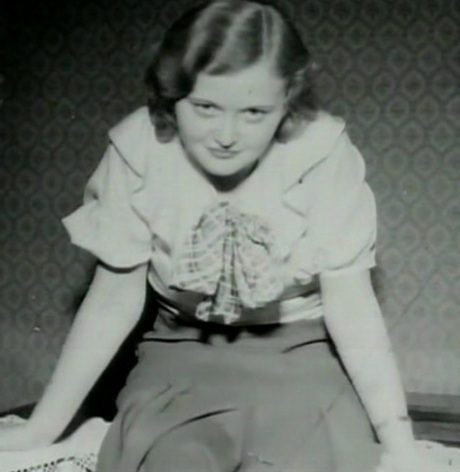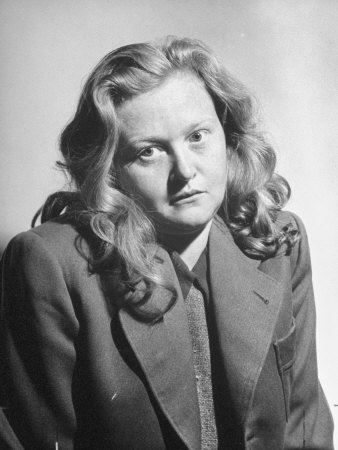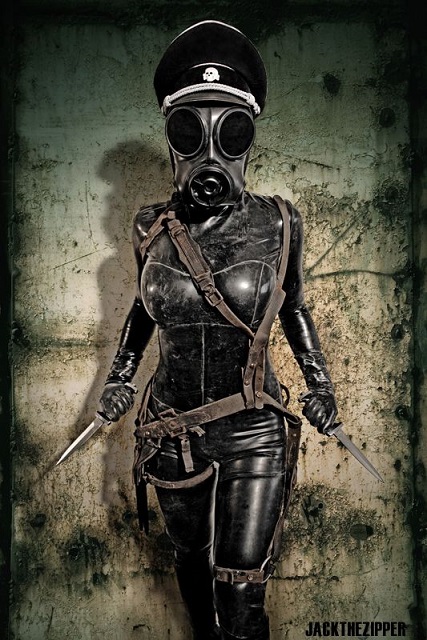Ilse Koch
Introduction
Ilse Koch (née Köhler; 22 September 1906 – 1 September 1967) was the wife of Karl-Otto Koch, commandant of the Nazi concentration camps Buchenwald (from 1937 to 1941) and Majdanek (from 1941 to 1943). She was one of the first prominent Nazis to be tried by the US military.
After the trial was remitted under worldwide media attention, survivor accounts of her actions resulted in other authors describing her abuse of prisoners as sadistic, and the image of her as “the concentration camp murderess” was current in post-war German society. She was accused of taking souvenirs from the skin of murdered inmates with distinctive tattoos. She was known as “The Witch of Buchenwald” (“Die Hexe von Buchenwald”) by the inmates because of her alleged cruelty and lasciviousness toward prisoners. She is also called in English “The Beast of Buchenwald”, “The Bitch of Buchenwald”, “Queen of Buchenwald”, “Red Witch of Buchenwald”, and the “Butcher Widow”.
Early Life

Koch was born in Dresden, Germany, the daughter of a factory foreman. She was known as a polite and happy child in her elementary school. At the age of 15 she entered an accountancy school. Later, she went to work as a bookkeeping clerk. At the time the economy of Germany had not yet recovered from Germany’s defeat in World War I. In 1932 she became a member of the rising Nazi Party. Through some friends in the SA and SS, she met Karl Otto Koch in 1934, marrying him two years later.
War Crimes

In 1936, she began working as a guard and secretary at the Sachsenhausen concentration camp near Berlin, which her fiancé commanded, and was married the same year. In 1937 she came to Buchenwald when her husband was made Commandant.
In 1940, she built an indoor sports arena, which cost over 250,000 reichsmarks, most of which were seized from the inmates. In 1941 she became an Oberaufseherin (“chief overseer (female)”) over the few female guards who served at the camp. In 1941 Karl Otto Koch was transferred to Lublin, where he helped establish the Majdanek concentration and extermination camp. Ilse Koch remained at Buchenwald until 24 August 1943, when she and her husband were arrested on the orders of Josias von Waldeck-Pyrmont, SS and Police Leader for Weimar, who had supervisory authority over Buchenwald. The charges against the Kochs comprised private enrichment, embezzlement, and the murder of prisoners to prevent them giving testimony.
Ilse Koch was imprisoned until 1944 when she was acquitted for lack of evidence, but her husband was found guilty and sentenced to death by an SS court in Munich, and was executed in Buchenwald in April 1945. She went to live with her surviving family in the town of Ludwigsburg, where she was arrested by U.S. authorities on 30 June 1945.
Her Imprisonment
Koch and 30 other accused were arraigned before the American military court at Dachau (General Military Government Court for the Trial of War Criminals) in 1947. Prosecuting her was future United States Court of Claims Judge Robert L. Kunzig. She was charged with “participating in a criminal plan for aiding, abetting and participating in the murders at Buchenwald.”
Ilse Koch announced in the courtroom that she was pregnant. She was indeed 8 months pregnant. Frau Koch already had a reputation for being promiscuous. According to the Buchenwald Report, it was rumored that Ilse Koch was having simultaneous love affairs with Dr. Waldemar Hoven, a Waffen-SS Captain who was the chief medical doctor at Buchenwald, and Hermann Florstedt, the Deputy Commandant. Dachau court reporter, Joseph Halow, in his book “Innocent at Dachau,” there were unverified rumors that Frau Koch had engaged in numerous affairs with SS officers, and even with some of the inmates at the Buchenwald concentration camp and her marital relationship was an open one. Ilse Koch’s announcement of her pregnancy stunned the court because she was 41 years old at the time and was being kept in isolation with no contact with any men except the American interrogators, most of whom were Jewish. He also mentions that he was shocked to learn that Ilse Koch may have turned to other men because her husband was a “homosexual”. Buchenwald records revealed that he had been treated for syphilis. Halow further claimed, there was speculation among the court reporters that the father was Josef Kirschbaum, a Jewish interrogator who was one of the few men who had access to her prison cell. On 19 August 1947 she was sentenced to life imprisonment for “violation of the laws and customs of war”.
After she had served two years of her sentence, General Lucius D. Clay, the interim military governor of the American Zone in Germany, reduced the judgment to four years’ prison on 8 June 1948 on the grounds “there was no convincing evidence that she had selected inmates for extermination in order to secure tattooed skins, or that she possessed any articles made of human skin.”
Jean Edward Smith in his biography, Lucius D. Clay, an American Life, the general maintained that the leather lamp shades were really made out of goat skin. The book quotes a statement made by General Clay years later:
There was absolutely no evidence in the trial transcript, other than she was a rather loathsome creature, that would support the death sentence. I suppose I received more abuse for that than for anything else I did in Germany. Some reporter had called her the “Bitch of Buchenwald”, had written that she had lamp shades made of human skin in her house. And that was introduced in court, where it was absolutely proven that the lamp shades were made out of goat skin.
According to the Buchenwald Report, there was a factory at Buchenwald, which produced leather goods out of animal skins, but it had caught on fire during an Allied bombing raid on the camp on August 24, 1944.
News of the reduced sentence did not become public until 16 September 1948. Despite the ensuing uproar, Clay stood firm. Under the pressure of public opinion Koch was re-arrested in 1949 and tried before a West German court. The hearing opened on 27 November 1950 before the Assize Court at Augsburg and lasted seven weeks, during which 250 witnesses were heard including 50 for the defense. Koch collapsed and had to be carried from the court in late December 1950, and again on 11 January 1951. At least four separate witnesses for the prosecution testified that they had seen Ilse Koch choose tattooed prisoners, who were then killed, or had seen or been involved in the process of making human-skin lampshades from tattooed skin. However, this charge was dropped by the prosecution when they could not prove lampshades or any other items were actually made from human skin.
On 15 January 1951, the Court pronounced its verdict, in a 111-page long decision, for which Koch was not present in court. It was concluded that the previous trials in 1944 and 1947 were not a bar to proceedings under the principle of ne bis in idem, as at the 1944 trial Koch had only been charged with receiving, while in 1947 she had been accused of crimes against foreigners after 1 September 1939, and not with crimes against humanity of which Germans and Austrians had been defendants both before and after that date. She was convicted of charges of incitement to murder, incitement to attempted murder, and incitement to the crime of committing grievous bodily harm, and on 15 January 1951 was sentenced to life imprisonment and permanent forfeiture of civil rights.
Koch appealed to have the judgment quashed, but the appeal was dismissed on 22 April 1952 by the Federal Court of Justice. She later made several petitions for a pardon, all of which were rejected by the Bavarian Ministry of Justice. Ilse protested her life sentence, to no avail, to the International Human Rights Commission.
Karl and Ilse Koch had two sons, including one who committed suicide after the war, allegedly because he couldn’t live with the shame of the crimes of his parents. Ilse also had another son, the one that was conceived while she was in a prison cell at Dachau. He was born in the Aichach prison near Dachau where she was sent to serve her life sentence, and was immediately taken from her. At the age of 19, he found out that Ilse Koch was his mother, and he began visiting her regularly at Aichach. They got along well and Ilse wrote poetry for her son.
Her Death
Koch committed suicide by hanging herself at Aichach women’s prison on 1 September 1967; she was 60 years old. On one of his scheduled visits, Ilse’s son was stunned to learn that she had killed herself the night before. Today the body of the “Bitch of Buchenwald” lies in an unmarked and untended grave in the cemetery at Aichach. According to Joseph Halow, author of “Innocent at Dachau,” her son disappeared after learning of his mother’s suicide.
After-Life
Ilse Koch's Statistics
Circa: 2032 C.E.
Plots:
Secrets:
Spectral Caste: Dopplegangers
Haunt:
Born: 1906
Died: 1967
Nature: Deviant
Demeanor: Sadist, originally Conformist.
Apparent Age: That varies quite a lot as Ilse has the arcanos of Moliate and is quite skilled in using it. While she has the potential for endless variety, she usually takes only three forms. Her innocent seeming adolescent form allows her to get the drop on other wraiths and reminds her of an imaginary, but beatific yesteryear. The form she uses less and less, is that of her more mature and wanton self, a self image from the time in which she dominated the prisoners and guards of Buchenwald alike. Her third form, is that of a militant dominant in black leather fetish gear. None of these forms are her true self which consists of an emaciated and elderly Ilse in her late sixties, who bears the death-mark of suicide on her forehead and rope-burns around her thick neck.
Physical: Strength 2, Dexterity 3, Stamina 2
Social: Charisma 3, Manipulation 5, Appearance 3 (most of the time, but not always)
Mental: Perception 3, Intelligence 3, Wits 3
Talents: Alertness, Athletics, Brawl, Dodge, Empathy, Expression, Intimidation, Leadership, Streetwise, Subterfuge
Skills: Animal Ken, Crafts, Drive, Etiquette, Firearms, Melee, Performance, Security, Stealth, Survival
Knowledges: Academics, Computers, Finance, Investigation, Law, Linguistics, Medicine, Occult, Politics, Science
Arcanoi: Moliate 3
Dark Arcanoi: Hive-Mind 3, Shroud-Rending 3, Tempest Weaving 1
Backgrounds: Allies, Contacts, Fame 3, Influence, Mentor, Resources, Retainers 2 (Fetches), Status 2 (Spectres), Shadowlands 3
Flaws:
Merits:
Being:
Corpus:
Destiny:
